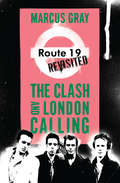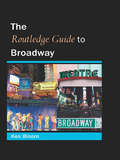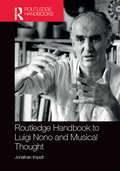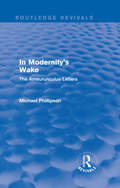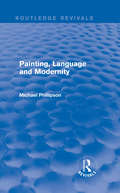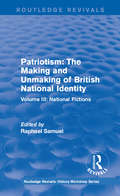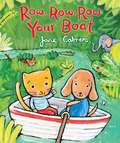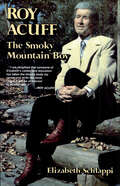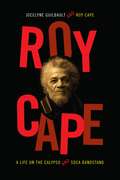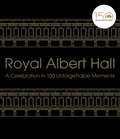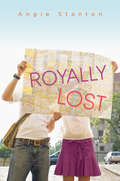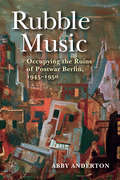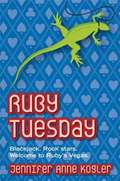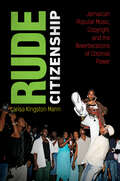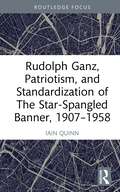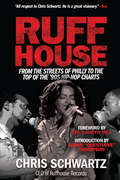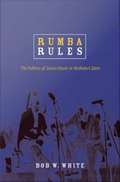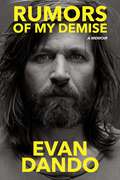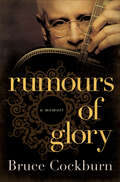- Table View
- List View
Route 19 Revisited: The Clash and London Calling
by Marcus GrayTwenty-eight years after its original release, The Clash's London Calling was inducted into the Grammy Hall of Fame as a "recording of lasting qualitative or historical significance." It topped polls on both sides of the Atlantic for the best album of the seventies (and eighties) and in publications as wide-ranging as Rolling Stone, VIBE, Pitchfork, and NME, and it regularly hits the top ten on greatest-albums-of-all-time-lists. Even its cover-the instantly recognizable image of Paul Simonon smashing his bass guitar-has attained iconic status, inspiring countless imitations and even being voted the best rock 'n' roll photograph ever by Q magazine.Now the breakthrough album from the foremost band of the punk era gets the close critical eye it deserves. Marcus Gray examines London Calling from every vantage imaginable, from the recording sessions and the state of the world it was recorded in to the album's long afterlife, bringing new levels of understanding to one of punk rock's greatest achievements. Leaving no detail unexplored, he provides a song-by-song breakdown covering when each was written and where, what inspired each song, and what in turn each song inspired, making this book a must-read for Clash fans.
Routledge Guide to Broadway
by Ken BloomThe Routledge Guide to Broadway is the second title in our new student reference series. It will introduce the student to the Broadway theater, focusing on key performers, writers, directors, plays, and musicals, along with the theaters themselves, key awards, and the folklore of Broadway.Broadway is the center of American theater, where all the great plays and musicals make their mark. Students across the country in theater history, performance, and direction/production look to Broadway for their inspiration. While there are illustrated coffee table type books on Broadway, there are few that offer a comprehensive look at the key figures and productions of the last two centuries. The Routledge Guide to Broadway offers this information in an easy-to-use, inexpensive format that will appeal to students, professors, and theatrical professionals.
Routledge Handbook of Asian Music: Cultural Intersections
by Lee Tong SoonThe Routledge Handbook of Asian Music: Cultural Intersections introduces Asian music as a way to ask questions about what happens when cultures converge and how readers may evaluate cultural junctures through expressive forms. The volume’s thirteen original chapters cover musical practices in historical and modern contexts from Central Asia, East Asia, South Asia, and Southeast Asia, including art music traditions, folk music and composition, religious and ritual music, as well as popular music. These chapters showcase the diversity of Asian music, requiring readers to constantly reconsider their understanding of this vibrant and complex area. The book is divided into three sections: Locating meanings Boundaries and difference Cultural flows Contributors to the book offer a multidisciplinary portfolio of methods, ranging from archival research and field ethnography to biographical studies and music analysis. In addition to rich illustrations, numerous samples of notation and sheet music are featured as insightful study resources. Readers are invited to study individuals, music-makers, listeners, and viewers to learn about their concerns, their musical choices, and their lives through a combination of humanistic and social-scientific approaches. Demonstrating how transformative cultural differences can become in intercultural encounters, this book will appeal to students and scholars of musicology, ethnomusicology, and anthropology.
Routledge Handbook to Luigi Nono and Musical Thought (Routledge Music Handbooks)
by Jonathan ImpettOf the post-war, post-serialist generation of European composers, it was Luigi Nono who succeeded not only in identifying and addressing aesthetic and technical questions of his time, but in showing a way ahead to a new condition of music in the twenty-first century. His music has found a listenership beyond the ageing constituency of ‘contemporary music’. In Nono’s work, the audiences of sound art, improvisation, electronic, experimental and radical musics of many kinds find common cause with those concerned with the renewal of Western art music. His work explores the individually and socially transformative role of music; its relationship with history and with language; the nature of the musical work as distributed through text, time, technology and individuals; the nature and performativity of the act of composition; and, above all, the role and nature of listening as a cultural activity. In many respects his music anticipates the new technological state of culture of the twenty-first century while radically reconnecting with our past. His work is itself a case study in the evolution of musical activity and the musical object: from the period of an apparently stable place for art music in Western culture to its manifold new states in our century. Routledge Handbook to Luigi Nono and Musical Thought seeks to trace the evolution of Nono’s musical thought through detailed examination of the vast body of sketches, and to situate this narrative in its personal, cultural and political contexts.
Routledge Revivals (1989): The Ameurunculus Letters
by Michael PhillipsonFirst published in 1988, this book attempts to tackle the problem of how to write about art, culture, and the issues of postmodernism in a style appropriate to what is being claimed. The letters are written on art’s behalf to a range of institutions and individuals, and have as their recurring concern the relation between art, culture and representation — both art as representation and how art is represented to, and for, the surrounding culture. They explore the context and viability of art through a range of themes, including writing, the aestheticisation of everyday life, style, design pleasure, fragmentation, hyphenation, technology, and the museum — drawing on materials from the visual arts, music, literature, post-structuralism, contemporary criticism, philosophy, and sociology.
Routledge Revivals: Painting, Language and Modernity (1985)
by Michael PhillipsonFirst published in 1985, this book draws together the author’s artistic with analytical practices which had been developed over many years of sociological enquiry. It interprets a ‘work of art’ as a site on which a viewer or critic is invited to share in questioning celebration of the painting itself. The author reassesses modern painting’s relation to its own origins and to tradition in light of the emergence of ‘postmodern’ practice — exploring its engagement of fundamental questions about language and being. Also assessed is the relevance of the metaphors of writings and Reading to an understanding of painting and viewing practices — looking at painters’ writings as well as phenomenological and post-structuralist writers.
Routledge Revivals: Volume III: National Fictions (Routledge Revivals: History Workshop Series)
by Raphael SamuelFirst published in 1989, this is the third of three volumes exploring the changing notions of patriotism in British life from the thirteenth century to the late twentieth century and constitutes an attempt to come to terms with the power of the national idea through a historically informed critique. This volume studies some of the leading figures of national myth, such as Britannia and John Bull. One group of essays looks at the idea of distinctively national landscape and the ways in which it corresponds to notions of social order. A chapter on the poetry of Edmund Spenser explores metaphorical representations of Britain as a walled garden, and the idea of an enchanted national space is taken up in a series of essays on literature, theatre and cinema. An introductory piece charts some of the startling changes in the image of national character, from the seventeenth-century notion of the English as the most melancholy people in Europe, to the more uncertain and conflicting images of today.
Row, Row, Row Your Boat
by Jane CabreraJane Cabrera's signature bold hues and lively animal characters are a delight in this version of the well-loved children's song, with new lyrics that encourage young readers to sing along.
Row, Row, Row Your Boat (Jane Cabrera's Story Time)
by Jane CabreraRead, row, and roar along - a newly imagined favorite will have everyone singing.In this vibrantly-painted rain forest, squeak, bark, and chatter along with a kitten and puppy rowing their way down the stream. Uncover one delightful animal surprise after another. Sheet music with guitar chords, along with Cabrera's jaunty new verses, is included.Jane Cabrera's Story Time celebrates children's best-loved read along nursery rhymes and songs. These interactive favorites are given a new twist by award-winning artist Jane Cabrera and feature her bold, bright, kid-friendly illustrations. Don't miss the other delightful nursery-rhyme titles, including Here We Go Round the Mulberry Bush, If You're Happy and You Know It, and One, Two, Buckle My Shoe.
Roy Acuff: The Smoky Mountain Boy
by Elizabeth Schlappi"An important and especially fitting tribute." -Country Music Magazine"One of the best studies of a country music personality that has been issued to date." -The Journal of Country Music"Must reading for fans, scholars, or anyone who has more than a passing interest in Roy Acuff." -The Nashville Banner"When a king dies, the people of the land proclaim, 'The King is dead! Long live the King!' However, in this case, there is an empty throne, for there will never be another King." -Elizabeth SchlappiAcuff was the first living performer to be inducted into the Country Music Hall of Fame. He was an artist whose devotion to his work boosted not only his own career, but also the credibility and popularity of his field. This country music legend helped bring the fledgling industry and its capital, The Grand Ole Opry, from the classification of regional entertainment to a certified national institution.His career began back in 1938, when this son of a small-town Baptist preacher made his first appearance on the famed stage in Nashville. This first step toward stardom transformed his life. Roy Acuff: The Smoky Mountain Boy draws upon personal interviews with Acuff's contemporaries, friends, and family as well as Acuff himself. This combination honors Acuff by tracing the roots of his career through the evolution of his musical style and his distinctive American art form. He died on November 23, 1992
Roy Cape: A Life on the Calypso and Soca Bandstand
by Jocelyne Guilbault Roy CapeRoy Cape is a Trinidadian saxophonist active as a band musician for more than fifty years and as a bandleader for more than thirty. He is known throughout the islands and the Caribbean diasporas in North America and Europe. Part ethnography, part biography, and part Caribbean music history, Roy Cape is about the making of reputation and circulation, and about the meaning of labor and work ethics. An experiment in storytelling, it joins Roy's voice with that of ethnomusicologist Jocelyne Guilbault. The idea for the book emerged from an exchange they had while discussing Roy's journey as a performer and bandleader. In conversation, they began experimenting with voice, with who takes the lead, who says what, when, to whom, and why. Their book reflects that dynamic, combining first-person narrative, dialogue, and the polyphony of Roy's bandmates' voices. Listening to recordings and looking at old photographs elicited more recollections, which allowed Roy to expand on recurring themes and motifs. This congenial, candid book offers different ways of knowing Roy's labor of love--his sound and work through sound, his reputation and circulation as a renowned musician and bandleader in the world.
Royal Albert Hall: A celebration in 150 unforgettable moments
by Royal Albert HallThe most iconic concert hall in the world celebrates 150 years with a stunning review of history's finest performances and performers. Opening with a personal letter from Queen Elizabeth II, this beautiful book celebrates 150 moments that have shaped The Royal Albert Hall over the last century and a half. From The Beatles to the Suffragettes, Albert Einstein to Winston Churchill, Mohammed Ali to B.B. King, few other buildings have housed such a stunning variety of era-defining people and events.This gorgeous, illustrated guide takes you behind the scenes of one of the most well-loved concert halls in the world, offering insights into the building’s iconic architecture, as well as its lesser-known quirks such as the reinforced toilets designed for Sumo wrestlers. This book features events ranging from the world's first sci-fi convention in 1891 to the annual Cirque du Soleil, which requires the auditorium to be transformed into a gymnasium. Autographs and candid comments from incredible performers who have appeared on its stage, like Russell Howard, Eric Clapton and Katie Derham, give a unique insider’s perspective on an esteemed and beloved British institution. With never-before-seen images, insights and more, this is the ultimate celebration of a British architectural icon which continues to inspire artists and audiences from around the world.
Royally Lost
by Angie StantonPerfect for fans of Sarah Dessen, Susane Colasanti, and Jenny Han, Angie Stanton's brand-new romance asks the question, What would it be like to fall in love with a prince?Dragged on a family trip to Europe, Becca wants nothing more than to go home. Trapped with her emotionally distant father, overeager stepmother, and a brother who only wants to hook up with European hotties, Becca is miserable. Until she meets Nikolai.Nikolai has everything--he's a crown prince, heir to the throne, and girls adore him. But the one thing he doesn't have is freedom . . . so he flees his kingdom and goes on his own European trip.And when Nikolai and Becca meet, sparks fly. But Becca's family vacation ends in a matter of days. Will Nikolai and Becca be forced to say good-bye, or will they change history forever?
Royally Lost
by Angie StantonPerfect for fans of Sarah Dessen, Susane Colasanti, and Jenny Han, Angie Stanton's brand-new romance asks the question, What would it be like to fall in love with a prince?Dragged on a family trip to Europe, Becca wants nothing more than to go home. Trapped with her emotionally distant father, overeager stepmother, and a brother who only wants to hook up with European hotties, Becca is miserable. Until she meets Nikolai.Nikolai has everything--he's a crown prince, heir to the throne, and girls adore him. But the one thing he doesn't have is freedom . . . so he flees his kingdom and goes on his own European trip.And when Nikolai and Becca meet, sparks fly. But Becca's family vacation ends in a matter of days. Will Nikolai and Becca be forced to say good-bye, or will they change history forever?
Rubble Music: Occupying the Ruins of Postwar Berlin, 1945–1950
by Abby AndertonAs the seat of Hitler’s government, Berlin was the most frequently targeted city in Germany for Allied bombing campaigns during World War II. Air raids shelled celebrated monuments, left homes uninhabitable, and reduced much of the city to nothing but rubble. After the war’s end, this apocalyptic landscape captured the imagination of artists, filmmakers, and writers, who used the ruins to engage with themes of alienation, disillusionment, and moral ambiguity. In Rubble Music, Abby Anderton explores the classical music culture of postwar Berlin, analyzing archival documents, period sources, and musical scores to identify the sound of civilian suffering after urban catastrophe. Anderton reveals how rubble functioned as a literal, figurative, psychological, and sonic element by examining the resonances of trauma heard in the German musical repertoire after 1945. With detailed explorations of reconstituted orchestral ensembles, opera companies, and radio stations, as well as analyses of performances and compositions that were beyond the reach of the Allied occupiers, Anderton demonstrates how German musicians worked through, cleared away, or built over the debris and devastation of the war.
Rubble Music: Occupying the Ruins of Postwar Berlin, 1945–1950
by Abby AndertonThis musicologist&’s exploration of classical music culture in post-WWII Berlin evokes the power of music in the face of trauma and tragedy.As the seat of Hitler's government, Berlin was the most frequently targeted German city for Allied bombing during World War II. Air raids shelled celebrated monuments and reduced much of the city to rubble. After the war's end, this apocalyptic landscape captured the imagination of artists, filmmakers, and writers, who used the ruins to engage with themes of alienation, disillusionment, and moral ambiguity.In Rubble Music, Abby Anderton explores the classical music culture of postwar Berlin, analyzing archival documents, period sources, and musical scores to identify the sound of civilian suffering after urban catastrophe. Anderton reveals how rubble functioned as a literal, figurative, psychological, and sonic element by examining the resonances of trauma heard in the German musical repertoire after 1945. With detailed explorations of reconstituted orchestral ensembles, opera companies, and radio stations, as well as analyses of performances and compositions that were beyond the reach of the Allied occupiers, Anderton demonstrates how German musicians worked through, cleared away, or built over the debris and devastation of the war.
Ruby Tuesday
by Jennifer Anne KoglerRuby Tuesday's life just got a little bit crazier. When a murder in the family exposes some unexpected secrets, Ruby Tuesday has to leave her parents' O.C. beach house for a life-or-death road trip to Vegas. Her mom's closest friends are rock stars and her father is a professional gambler, but neither of them has prepared Ruby Tuesday for what's waiting in Nevada. Ruby needs a crash course, and she's about to get one, straight from the queen of hearts.
Rude Citizenship: Jamaican Popular Music, Copyright, and the Reverberations of Colonial Power
by Larisa Kingston MannIn this deep dive into the Jamaican music world filled with the voices of creators, producers, and consumers, Larisa Kingston Mann—DJ, media law expert, and ethnographer—identifies how a culture of collaboration lies at the heart of Jamaican creative practices and legal personhood. In street dances, recording sessions, and global genres such as the riddim, notions of originality include reliance on shared knowledge and authorship as an interactive practice. In this context, musicians, music producers, and audiences are often resistant to conventional copyright practices. And this resistance, Mann shows, goes beyond cultural concerns.Because many working-class and poor people are cut off from the full benefits of citizenship on the basis of race, class, and geography, Jamaican music spaces are an important site of social commentary and political action in the face of the state's limited reach and neglect of social services and infrastructure. Music makers organize performance and commerce in ways that defy, though not without danger, state ordinances and intellectual property law and provide poor Jamaicans avenues for self-expression and self-definition that are closed off to them in the wider society. In a world shaped by coloniality, how creators relate to copyright reveals how people will play outside, within, and through the limits of their marginalization.
Rudolph Ganz, Patriotism, and Standardization of The Star-Spangled Banner, 1907-1958
by Iain QuinnThis book examines the succession of events toward the potential standardization of the music for “The Star-Spangled Banner” from an initial letter to President Roosevelt in 1907 to the 1958 congressional hearings on the National Anthem, and the later work of the Swiss-Born American pianist, Rudolph Ganz. These events took place across five decades when a culture of public patriotism was especially pronounced for immigrant musicians. This book contextualizes the complementary experiences of a leading immigrant musician, Ganz, who successfully navigated the world of public patriotism while pursuing the realization of a standardized version. The materials are discussed through the lens of the performance practice. The legacy of standardization has not previously been examined. The response and actions of an immigrant, Ganz, in a culture of necessary patriotism for foreign-born artists shed important new light on this topic. It demonstrates the challenges, fears, and cultural expectations regarding the standardization of an important patriotic work.
Ruffhouse: From the Streets of Philly to the Top of the '90s Hip-Hop Charts
by Chris SchwartzThe Ruffhouse Records founder tells how he overcame poverty, abuse, and addiction to start a label that launched some of music's biggest stars: &“Gripping.&”—Philadelphia Magazine As a struggling musician trying to catch a break in 1980s Philadelphia, Chris Schwartz navigated the crime-infested, morally bankrupt music industry to found and build one of the most successful hip-hop record labels in the world. That label was Ruffhouse, which launched the careers of Nas, The Fugees, Cypress Hill, and others, dominating the charts and generating global revenues of over a billion dollars. Schwartz and his partner, Joe Nicolo, built Ruffhouse from one desk and a phone to one of hip-hop's most revered record companies while simultaneously struggling with drug addiction and alcoholism. A story of money, greed, envy, betrayal, violence, addiction, loss, and redemption, not to mention a whole lot of music, Ruffhouse reveals the inside story of the record companies, recording studios, tour buses, private jets, mansions, radio stations, and concert halls at the height of hip-hop's 1990s heyday while also uncovering the darker side of the business, from police stations to rehab clinics, courtrooms to prisons. Told in Schwartz's own candid, searing prose, Ruffhouse is a portrayal of hip-hop culture at its tipping point, as it transitioned from urban curiosity to global phenomenon. &“[A] story of adversity and perseverance…Fans of these artists will love the insider information on the recording process and the trials and tribulations of getting this music out into the world.&”―Library Journal &“All respect to Chris Schwartz. He is a great visionary.&”—Nas
Rugs, Guitars, and Fiddling: Intensification and the Rich Modern Lives of Traditional Arts
by Chris GoertzenWhat do exotic area rugs, handcrafted steel-string guitars, and fiddling have in common today? Many contemporary tradition bearers embrace complexity in form and content. They construct objects and performances that draw on the past and evoke nostalgia effectively but also reward close attention. In Rugs, Guitars, and Fiddling: Intensification and the Rich Modern Lives of Traditional Arts, author Chris Goertzen argues that this entails three types of change that can be grouped under an umbrella term: intensification. First, traditional creativity can be intensified through virtuosity, through doing hard things extra fluently. Second, performances can be intensified through addition, by packing increased amounts of traditional materials into the conventionally sized packages. Third, in intensification through selection, artistic impact can grow even if amount of information recedes by emphasizing compelling ideas—e.g., crafting a red and black viper poised to strike rather than a pretty duck decoy featuring more colors and contours.Rugs handwoven in southern Mexico, luthier-made guitars, and southern US fiddle styles experience parallel changes, all absorbing just enough of the complex flavors, dynamics, and rhythms of modern life to translate inherited folklore into traditions that can be widely celebrated today. New mosaics of details and skeins of nuances don’t transform craft into esoteric fine art, but rather enlist the twists and turns and endless variety of the contemporary world therapeutically, helping transform our daily chaos into parades of negotiable jigsaw puzzles. Intensification helps make crafts and traditional performances more accessible and understandable and thus more effective, bringing past and present closer together, helping folk arts continue to perform their magic today.
Ruins and Resilience: The Longevity of Experimental Film (Goldsmiths Press / Sonics Series)
by Karel DoingExperimental film practice from an international and transdisciplinary perspective.Karel Doing is an experimental filmmaker and researcher who has worked across the globe with fellow artists and filmmakers, creating a body of work that is difficult to pinpoint with a simple catchphrase. In Ruins and Resilience he weaves autobiographical elements and critical reviews together with his wide ranging interdisciplinary approach, reflecting on his own practice by positioning key works within the context of a vibrant experimental film scene in Europe, North and South America, and Asia. Doing demonstrates how experimental filmmakers have continued to renew their practice despite the almost total demise of analog motion picture film and the constant neglect of this art form by institutions and critics. Written in a fluent and accessible style, the book looks into the connections between the work of groundbreaking artists within the field and subjects such as transgression, improvisation, collectivity, materiality, phenomenology, and perception. Specifically, intersections with music and sound are investigated, appealing to the idea of the cross-modal brain, the ability to perceive sounds and images in an integrated way. Instead of looking again at the "golden era" of experimental film, the book starts in the 1980s, showing how this art form has never ceased to surprise and inspire. The author's hands-on engagement with the medium is formational for his more theoretical approach and writing, making the book a highly original contribution in the field that is informative and inspiring for academic and practitioners alike.
Rumba Rules: The Politics of Dance Music in Mobutu's Zaire
by Bob W. WhiteMobutu Sese Seko, who ruled Zaire (now the Democratic Republic of Congo) from 1965 until 1997, was fond of saying "happy are those who sing and dance," and his regime energetically promoted the notion of culture as a national resource. During this period Zairian popular dance music (often referred to as la rumba zaroise) became a sort of musica franca in many parts of sub-Saharan Africa. But how did this privileged form of cultural expression, one primarily known for a sound of sweetness and joy, flourish under one of the continent's most brutal authoritarian regimes? In Rumba Rules, the first ethnography of popular music in the Democratic Republic of Congo, Bob W. White examines not only the economic and political conditions that brought this powerful music industry to its knees, but also the ways that popular musicians sought to remain socially relevant in a time of increasing insecurity. Drawing partly on his experiences as a member of a local dance band in the country's capital city Kinshasa, White offers extraordinarily vivid accounts of the live music scene, including the relatively recent phenomenon of libanga, which involves shouting the names of wealthy or powerful people during performances in exchange for financial support or protection. With dynamic descriptions of how bands practiced, performed, and splintered, White highlights how the ways that power was sought and understood in Kinshasa's popular music scene mirrored the charismatic authoritarianism of Mobutu's rule. In Rumba Rules, Congolese speak candidly about political leadership, social mobility, and what it meant to be a bon chef (good leader) in Mobutu's Zaire.
Rumors of My Demise: A Memoir
by Evan DandoEvan Dando, front man of The Lemonheads and &“poster boy—and prettiest boy—of Gen X&” (The New York Times), spills the true story of his band&’s tumultuous history and what it was like to be famous in the pre-internet days in this candid, colorful, and unputdownable memoir. After Kurt Cobain&’s passing in 1994, everyone expected Evan Dando to be next. The Lemonheads front man, songwriter and actor started in the &’80s hardcore scene and went on to become a &’90s icon. Think of Evan Dando, and you think of heroin chic, grunge, and celebrity burnout. Perhaps known as much for his partying and boyish good looks, after two gold records and the kind of fame that you just can&’t enjoy anymore, the Lemonheads cooled off and life went on. Dando grew up in Boston, the son of a lawyer and a model, and attended the prestigious Commonwealth School. Fame was never what motivated him but the lure of the wild life proved trickier to refuse. From sneaking into concerts as a child, to sleeping on floors in the punk rock days, to crashing at Johnny Depp&’s place in Hollywood, he was right there in the thick of it. So much so, that social media once reported his death. Now, very much alive, sober, and enjoying a life in South America when he&’s not on the road, Evan Dando is going to tell his own story. His memoir will remind readers what was so great about the pre-internet &’90s: the innocence, the access, and the anonymity. Reclaiming the purity and exuberance of his early days and encapsulating the spirit of the era, this candid autobiography presents a portrait of an artist who lives wholly for his music, and one that makes no apologies for doing so.
Rumours of Glory: A Memoir
by Bruce CockburnAward-winning songwriter and pioneering guitarist Bruce Cockburn has been shaped by politics, protest, romance, and spiritual discovery. He has toured the globe, visiting far-flung places such as Guatemala, Mali, Mozambique, Afghanistan, and Nepal, performing and speaking out on diverse issues from native rights and land mines to the environment and Third World debt. His journeys have been reflected in his music and evolving styles: folk, jazz, blues, rock, and world beat. Drawing from his experiences, he continues to create memorable songs about his ever-expanding universe of wonders.As an artist with thirty-one albums, Cockburn has won numerous awards and the devotion of legions of fans across America and his native Canada. Yet the man himself has remained a mystery. In this memoir, Cockburn invites us into his private world and takes us on a lively cultural and musical tour through the late twentieth century, sharing his Christian convictions, his personal relationships, and the social and political activism that has defined him and has both invigorated and incited his fans.
